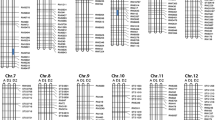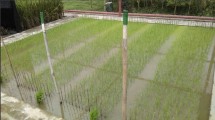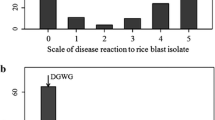Abstract
Rice bacterial blight (BB), caused by Xanthomonas oryzae pv. Oryzae (Xoo), is a serious disease in rice production worldwide. Rice cv. Zhenhui 084, a newly developed strong indica restorer line, exhibits high resistance to most of the Philippine races of BB and has been widely used in rice hybrids in China; however, the resistance gene has not yet been cloned. Here, we show that the resistance of Zhenhui 084 to Xoo strains is similar to that of IRBB7 containing Xa7, a durable and broad resistance dominant gene for BB. To map the resistance gene in Zhenhui 084, a F2 population with 331 highly susceptible individuals derived from a cross between Chenghui 448 and Zhenhui 084 was built. We finely mapped the target R gene to a region between two proximal markers RM20576 and MY4 in rice chromosome 6. A marker-based physical map of chromosome six was used to construct the contig covering the genomic region between two markers RM20576 and MY4. The target gene was assumed to be in an interval of approximate 200 kb, in which 16 candidate genes were predicted. Our findings will greatly facilitate the isolation and characterisation of the target R gene allelic to Xa7. Additionally, two PCR-based markers, tightly linked to the target R gene locus, will be a useful tool for the marker-assisted selection of the target R gene allelic to Xa7 in breeding programmes.



Similar content being viewed by others
References
Babujee, L., & Gnanamickam, S. S. (2000). Molecular tools for characterization of rice blast pathogen (Magnaporthe grisea) population and molecular marker-assisted breeding for disease resistance. Current Science, 78, 248–257.
Banerjee, D., Zhang, X., & Bent, A. F. (2001). The leucine-rich repeat domain can determine effective interaction between RPS2 and other host factors in Arabidopsis RPS2-mediated disease resistance. Genetics, 158, 439–450.
Bonas, U., Stall, R. E., & Staskawicz, B. (1989). Genetic and structural characterization of the avirulence gene avrBs3 from Xanthomonas campestris pv. vesicatoria. Molecular Genetics and Genomics, 218, 127–136.
Cheema, K. K., Grewal, N. K., Vikal, Y., Sharma, R., Lore, J. S., Das, A. et al. (2008). A novel bacterial blight resistance gene from Oryza nivara mapped to 38 kb region on chromosome 4L and transferred to Oryza sativa L. Genetics Research, 90, 397–407.
Chen, H., Wang, S., & Zhang, Q. (2002). A new gene for bacterial blight resistance in rice located on chromosome 12 identified from Minghui 63, and elite restorer line. Phytopathology, 92, 750–754. doi:10.1094/PHYTO.2002.92.7.750.
Chen, S., Huang, Z. H., Zeng, L. X., Yang, J. Y., Liu, Q. G., & Zhu, X. Y. (2008). High-resolution mapping and gene prediction of Xanthomonas oryzae pv. oryzae resistance gene Xa7. Molecular Breeding, 22, 433–441. doi:10.1007/s11032-008-9187-1.
Chu, Z. H., Yuan, M., Yao, J. L., Ge, X. J., Yuan, B., Xu, C. G., et al. (2006). Promoter mutations of an essential gene for pollen development result in disease resistance in rice. Genes & Development, 20, 1250–1255. doi:10.1101/gad.1416306.
Ezuka, A., & Sakaguchi, S. (1978). Host-parasite relationship in bacterial blight of rice caused by Xanthomonas oryzae pv. oryzae. Review of Plant Protection Research, 11, 93–118.
Gu, K. Y., Yang, B., Tian, D. S., Wu, L. F., Wang, D. J., Sreekala, C., et al. (2005). R gene expression induced by a type-III effector triggers disease resistance in rice. Nature, 435, 1122–1125. doi:10.1038/nature03630.
Henrissat, B. (1998). Glycosidase families. Biochemical Society Transactions, 26, 153–156.
Hopkins, C. M., White, F. F., Choi, S. H., Guo, A., & Leach, J. E. (1992). Identification of a family of avirulence genes from Xanthomonas oryzae pv. oryzae. Molecular Plant-Microbe Interactions, 5, 451–459.
Huang, N., Angeles, E. R., Domingo, J., Magpantay, G., Singh, S., Zhang, G., et al. (1997). Pyramiding bacterial blight resistance genes in rice: Marker assisted selection using RFLP and PCR. Theoretical and Applied Genetics, 95, 313–320. doi:10.1007/s001220050565.
IRGSP (2005). The map-based sequence of the rice genome. Nature, 436, 793–800.
Iyer, A. S., & McCouch, S. R. (2004). The rice bacterial blight resistance gene xa5 encodes a novel form of disease resistance. Molecular Plant-Microbe Interactions, 17, 1348–1354. doi:10.1094/MPMI.2004.17.12.1348.
Jiang, G. H., Xia, Z. H., Zhou, Y. L., Wan, J., Li, D. Y., Chen, R. S., et al. (2006). Testifying the rice bacterial blight resistance gene xa5 by genetic complementation and further analyzing xa5 (Xa5) in comparison with its homolog TFIIAc1. Molecular Genetics and Genomics, 275, 354–366. doi:10.1007/s00438-005-0091-7.
Kauffman, H. E., Reddy, A. P. K., Hsieh, S. P. Y., & Merca, S. D. (1973). An improved technique for evaluating resistance of rice varieties to Xanthomonas oryzae pv. oryzae. Plant Disease Report, 57, 537–541.
Kehres, D. G., Zaharik, M. L., Finlay, B. B., & Maguire, M. E. (2000). The NRAMP proteins of Salmonella typhimurium and Escherichia coli are selective manganese transporters involved in the response to reactive oxygen. Molecular Microbiology, 36, 1085–1100. doi:10.1046/j.1365-2958.2000.01922.x.
Khush, G. S., & Angeles, E. R. (1999). A new gene for resistance to race 6 of bacterial blight in rice, Oryza sativa L. Rice Genetics Newsletter, 16, 92–93.
Larsen, C. N., & Wang, H. (2002). The ubiquitin superfamily: members, features, and phylogenies. Journal of Proteome Research, 5, 411–419. doi:10.1021/pr025522n.
Lee, K. S., Rasabandith, S., Angeles, E. R., & Khush, G. S. (2003). Inheritance of resistance to bacterial blight in 21 cultivars of rice. Phytopathology, 93, 147–152. doi:10.1094/PHYTO.2003.93.2.147.
Leach, J. E., & White, F. F. (1996). Bacterial avirulence genes. Annual review of Phytopathology, 34, 153–179. doi:10.1146/annurev.phyto.34.1.153.
Lin, X. H., Zhang, D. P., Xie, Y. F., Gao, H. P., & Zhang, Q. (1996). Identifying and mapping a new gene for bacterial blight resistance in rice based on RFLP markers. Phytopathology, 86, 1156–1193. doi:10.1094/Phyto-86-1156.
Marchler-Bauer, A., Anderson, J. B., Derbyshire, M. K., DeWeese-Scott, C., Gonzales, N. R., Gwadz, M., et al. (2007). CDD: a conserved domain database for interactive domain family analysis. Nucleic Acids Research, 35, D237–D240. doi:10.1093/nar/gkl951.
Mew, T. W., & Vera Cruz, C. M. (1979). Variability of Xanthomonas oryzae pv. oryzae: Specificity in infection of rice differentials. Phytopathology, 69, 152–155. doi:10.1094/Phyto-69-152.
Nagato, Y., & Yoshimura, A. (1998). Report of the committee on gene symbolization, nomenclature and linkage groups. Rice Genetics Newsletter, 15, 13–74.
Nelson, N. (1999). Metal ion transporters and homeostasis. EMBO Journal, 18, 4361–4371. doi:10.1093/emboj/18.16.4361.
Ogawa, T., Yamamoto, T., Khush, G. S., & Mew, T. W. (1991). Breeding of near-isogenic lines of rice with single genes for resistance to bacterial blight pathogen (Xanthomonas oryzae pv. oryzae). Japanese Journal of Breeding, 41, 523–529.
Porter, B. W., Chittoor, J. M., Yano, M., Sasaki, T., & White, F. F. (2003). Development and mapping linked to the rice bacterial blight resistance gene Xa7. Crop Science, 43, 1484–1492.
Sablowski, R. W., & Meyerowitz, E. M. (1998). A homolog of NO APICAL MERISTEM is an immediate target of the floral homeotic genes APETALA3/PISTILLATA. Cell, 92, 93–103. doi:10.1016/S0092-8674(00)80902-2.
Sheng, S. L., Gong, H. B., Diao, L. P., Hu, C. M., Lin, T. Z., & Zhou, Y. W. (2002). Breeding and utilization of the indica rice restorer line Zhenhui 084. Hybrid Rice, 17, 627.
Sidhu, G. S., Khush, G. S., & Mew, T. W. (1978). Genetic analysis of bacterial blight resistance in seventy-four cultivars of rice, Oryza sativa L. Theoretical and Applied Genetics, 53, 105–111. doi:10.1007/BF00272687.
Singh, K., Vikal, Y., Mahajan, R., Cheema, K. K., Bhatia, D., Sharma, R., et al. (2007, October). Three novel bacterial blight resistance genes identified, mapped and transferred to cultivated rice O. sativa L. (Paper presented at the 2nd International Conference on Bacterial Blight of Rice, Nanjing).
Song, W. Y., Wang, G. L., Chen, L. L., Kim, H. S., Pi, L. Y., Holsten, T., et al. (1995). A receptor kinase-like protein encoded by the rice disease resistance gene, Xa21. Science, 270, 1804–1806. doi:10.1126/science.270.5243.1804.
Souer, E., Van Houwelingen, A., Kloos, D., Mol, J. N. M., & Koes, R. E. (1996). The no apical meristem gene of Petunia is required for pattern formation in embryos and flowers and is expressed at meristem and primordia boundaries. Cell, 85, 159–170. doi:10.1016/S0092-8674(00)81093-4.
Sun, X. L., Cao, Y. L., Yang, Z. F., Xu, C. G., Li, X. H., Wang, S. P., et al. (2004). Xa26, a gene conferring resistance to Xanthomonas oryzae pv. oryzae in rice, encodes an LRR receptor kinase-like protein. The Plant Journal, 7, 17–527.
Tan, G. X., Ren, X., Weng, Q. M., Shi, Z. Y., Zhu, L. L., & He, G. C. (2004). Mapping of a new resistance gene to bacterial blight in rice line introgressed from Oryza officinalis. Acta Genetica Sinica, 31, 724–729.
Vera Cruz, C. M., Bai, J. F., Ona, I., Leung, H., Nelson, R. J., Mew, T. W., et al. (2000). Predicting durability of a disease resistance gene based on an assessment of the fitness loss and epidemiological consequences of avirulence gene mutation. Proceedings of the National Academy of Sciences of the United States of America, 97, 13500–13505. doi:10.1073/pnas.250271997.
White, F. F., Yang, B., & Johnson, L. B. (2000). Prospects for understanding avirulence gene function. Current Opinion in Plant Biology, 3, 291–298. doi:10.1016/S1369-5266(00)00082-0.
Xiang, Y., Cao, Y. L., Xu, C. Q., Li, X. H., & Wang, S. P. (2006). Xa3, conferring resistance for rice bacterial blight and encoding a receptor kinase-like protein, is the same as Xa26. Theoretical and Applied Genetics, 113, 1347–1355. doi:10.1007/s00122-006-0388-x.
Yang, B., Zhu, W., Johnson, L. B., & White, F. F. (2000). The virulence factor AvrXa7 of Xanthomonas oryzae pv. oryzae is a type III secretion pathway-dependent nuclear-localized double-stranded DNA-binding protein. Proceedings of the National Academy of Sciences of the United States of America, 97, 9807–9812. doi:10.1073/pnas.170286897.
Yoshimura, S., Yamanouchi, U., Katayose, Y., Toki, S., Wang, Z. X., Kono, I., et al. (1998). Expression of Xa1, a bacterial blight resistance gene in rice, is induced by bacterial inoculation. Proceedings of the National Academy of Sciences of the United States of America, 95, 1663–1668. doi:10.1073/pnas.95.4.1663.
Zhang, Q., Lin, S. C., Zhao, B. Y., Wang, C. L., Yang, W. C., Zhou, Y. L., et al. (1998). Identification and tagging a new gene for resistance to bacterial blight (Xanthomonas oryzae pv. oryzae) from O. rufipogon. Rice Genetics Newsletter, 15, 138–142.
Acknowledgements
This work was supported by the National Natural Science Foundation of China (Grants No. 30771329, 30800677), the Zhejiang Normal University Innovative Research Team Programme, National Key Programmes for Transgenic Crops (2008ZX08009-003-001), and the Ph.D. Programme Foundation from the Ministry of Education (No. 20060307035) and the Programme for Changjiang Scholars and the Innovative Research Team in the University (PCISRT).
Author information
Authors and Affiliations
Corresponding author
Additional information
Y. Zhang and J. Wang contributed equally to this work.
Rights and permissions
About this article
Cite this article
Zhang, Y., Wang, J., Pan, J. et al. Identification and molecular mapping of the rice bacterial blight resistance gene allelic to Xa7 from an elite restorer line Zhenhui 084. Eur J Plant Pathol 125, 235–244 (2009). https://doi.org/10.1007/s10658-009-9478-3
Received:
Accepted:
Published:
Issue Date:
DOI: https://doi.org/10.1007/s10658-009-9478-3




